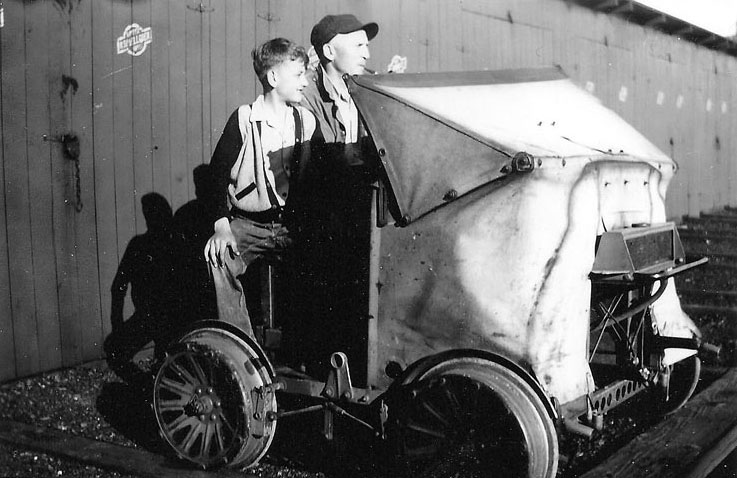Remembering – Track Motor Cars
|Home|
Do you remember those railroad motor cars we used to see in
the fifties and sixties on virtually every railroad line in the United
States & Canada? Those little yellow or orange “boxes” with
the characteristic putt-putt sound of a two-stroke engine, sometimes towing a
trailer or two loaded with ties and spikes.
Truman Koehn remembers and sent us this photo.

Truman writes: This
photo was taken around 1946 in Eagle Grove, IA
with my Dad, Ernest Koehn, on his one man Fairmont
motor car. Dad was a Traveling Mechanic
working north from Eagle Grove More
about him later. This was the Northern
Iowa Division of the C&NW Ry. There
was a substantial number of motor cars parked in these little sheds about a
block north of the C&NW depot on West Broadway at this point in time. I recall there was a coal chute nearby and
the huge railroad ice house in this same area.
The roundhouse was further north, a block or so.
During the fall, when I was older,
my Dad would borrow a gang motor car and on week ends during pheasant season
and half a dozen of us would climb on the gang Fairmont motor car, also know as
a speeder and head north on either the Burt or the Elmore line toward Fox Lake,
MN and hunt until we reached the Minnesota-Iowa state line. This was a common practice in those
days. Five or six guys could get their
limits rather nicely with this method, plus have a pleasant fall ride through
the Iowa countryside. We'd hunt up and back, spending the day
hunting pheasants along the railroad right of way and at times, the adjoining
corn fields. There was no problem with rail traffic as no trains operated on
week ends on one or both of these north lines as much of the traffic then was
seasonal. The railway permitted this; my
Dad would always get a clearance from the operator on duty in Eagle Grove, and
of course, everyone knew who needed to know, being informed that we were out on
the line hunting in a Motor Car. We'd
travel well over 100 miles in that Motor Car----hunting up and back, easily in
a day. Actually, it’s the "only" way to hunt pheasants, but sadly,
those days are over as the railroads no longer permit this type of activity
--nor do the hunting laws. But these were enjoyable days while this era
lasted---due primarily to so few hunters and so many native pheasants.
I recall many years when my uncle
Jack from Danville, IL
would come to Eagle Grove for these annual pheasant hunts. He always brought the VP of Sears Roebuck in Chicago
with him. Their limousine stuck out of
our garage by nearly 10 feet. One time
we came back to Eagle Grove after a days hunt with our shotguns still
loaded. Jack always bought along at
least one wooden case of shotgun shells so we had orders to shot freely.
As my Dad was putting away the
motor car, Uncle Jack spotted at least 50 pigeons circling the railroad coal
chute. Not wanting to either save the
shells or unload our guns, we all took aim at the pigeons right in the middle
of Eagle Grove, and for several minutes it rained pigeons. The noise was deafening. Police Chief Baker never showed up. I think he was hiding under his desk in the
police station!
A little history on these motor
cars….. The earliest 4 wheel track cars
were either powered by hand cranking, a pumping action or pedaling, the motion
being transmitted to the wheels by chains and gears. The first cars that used the internal
combustion engine for power did so via a direct drive, where the engine was
permanently connected to the drive axle. This meant that they had to be pushed
to start the engine and could not idle when stationary. Still, that was a distinct improvement over
cranking and pumping all day. The direct
drive was eventually replaced by the most common method of power transmission,
the drive belt. According to Fairmont
literature, a properly installed and used drive belt should last 40,000
miles. The rugged one-cylinder
two-stroke Fairmont engines used
from 1911 onwards were reversible, in that you could set the position of spark
ignition and then crank the engine in the required direction of travel. The name "putt-putt" for a motorcar
derives from the characteristic sound of these unmuffled two-stroke
engines.
A number of manufacturers supplied
rail cars to American Railroads. The
first was the Sheffield Motor Company, incorporated in 1878 by George
Sheffield, who saw the potential in selling velocipedes with flanged wheels to
the railroad companies. He did his
experimenting on the Michigan Central Railroad in the West Michigan
area at night and without authorization from the railroad. The Kalamazoo Velocipede and Motor Car
Company went into production in the early 1880's and lasted until 1968, when it
was bought by Tamper, Inc. of Columbia, South
Carolina and the factory closed down. The Fairmont Gas Engine and Railway Motor Car
Co. began in 1911 and by 1949 was offering 19 models of motorcars to customers,
most being available in 11 different gauges from 23" to 66". Demand was very strong for half a century,
but by the 1970's, sales were plummeting, due to the rapidly shrinking railroad
network and a widespread switch to Hy-rail vehicles. The last of a total of nearly 73,000 Fairmont
motor cars was manufactured in 1991.
Other companies of historical note included Adams, Buda, Casey Jones,
Fairbanks-Morse, North Western and the sole Canadian company, Woodings.
|Home|
Posted: 06/05/09
